#morte artu
Explore tagged Tumblr posts
Text

Mordred lays siege to the Tower of London, where Queen Guinevere, defended by two hundred knights, is concealed. Miniature from folio 81 verso of La Mort le Roi Artus (The Death of King Arthur), an Old French prose romance belonging to the Lancelot-Grail cycle. This manuscript, produced by an unknown hand ca. 1316, is now in the British Library.
#art#art history#Middle Ages#medieval#medieval art#Arthuriana#Arthurian legend#Guinevere#Mordred#miniature#manuscript illumination#illuminated manuscript#La Mort le Roi Artus#French art#14th century art#British Library
241 notes
·
View notes
Text

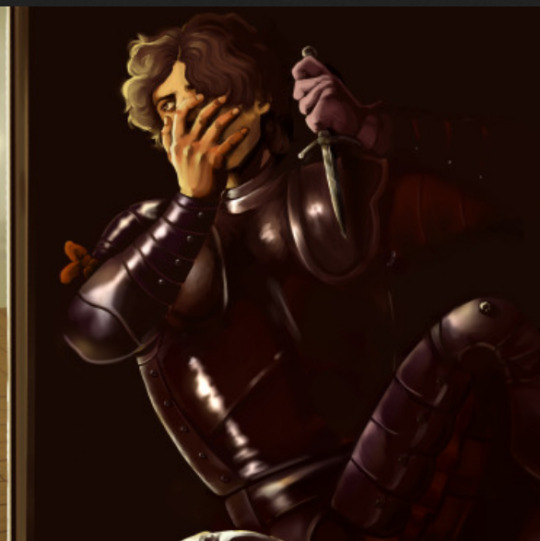

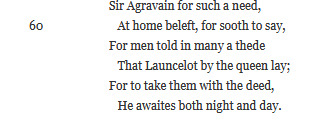
do you understand .
#sources are oxford classical dictionary/king artus/stanzaic morte#agravaine#arturiana#sir agravain#arthurian literature
63 notes
·
View notes
Text
Has anyone else noticed how both the Kingdom of Cameliard and the Lady of the Lake practically have no role or influence in the Fall of Camelot?
*Especially in the earlier French versions - Malory at least mentions Nimue being part of the Arthur rescue crew. This doesn't happen in the original French (Unless its the mysterious woman with Morgan that Griflet doesn't recognize. But Post-Vulgate doesn't mention her, however). But the question is: What was Nimue doing in all that time?
#fall of camelot#mort artu#lady of the lake#sir lancelot#queen guinevere#cameliard#arthurian mythology#arthurian legends#arthurian literature#arthuriana#my thoughts#nimue#leodegrance#carmelide
26 notes
·
View notes
Text
Griflet-centric Reincarnation AU following Mort Artu canon
Griflet remembers bits and pieces of his past life, mostly from Camlann, so he starts doing surface-level research on Arthuriana. Since he's the one to throw the sword in the lake in Mort Artu but Bedivere is best known for it, he becomes convinced that he's the reincarnation of Sir Bedivere.
There are two outcomes which immediately come to mind. One is that he runs into other Arthurian reincarnations. In this case, he might vastly confuse everyone, particularly if Bedivere shows up too. They might even think he's an imposter. However, they might remember who he actually was and have a laugh about the whole thing.
The other is that he never tells anyone, or only tells the people he's closest to, because he doesn't think anyone will believe him. He goes about the rest of his life secretly thinking he's Bedivere. It impacts nothing substantial, though from time to time he makes references which confuse the people around him and he's always kind of worried something will happen to his hand.
5 notes
·
View notes
Text
me, watching the characters of a book struggling against their fate, but I know they are all already doomed by the narrative

#Writing#Reading#Books#fantasy#Reader#Writer#You can fight your ennemies but you can't fight the writer my sweet child#Le morte le roi artu#Thomas Malory#It's VERY specific
2 notes
·
View notes
Text
I'm sure there are ways to read The Death of King Arthur without reading Gauvain as suicidal and trusting only Lancelot to be able to kill him but like. Are there.
#tw suicide#tw suicide ideation#tw suicidality#gauvain#gawain#lancelot#the death of king arthur#la mort li roi artu#la morte d'arthur
5 notes
·
View notes
Text
Beginner’s Guide to Medieval Arthuriana
Just starting out at a loss for where to begin?
Here’s a guide for introductory Medieval texts and informational resources ordered from most newbie friendly to complex. Guidebooks and encyclopedias are listed last.
All PDFs link to my Google drive and can be found on my blog. This post will be updated as needed.
Pre-Existing Resources
Hi-Lo Arthuriana
♡ Loathly Lady Master Post ♡
Medieval Literature by Language
Retellings by Date
Films by Date
TV Shows by Date
Documentaries by Date
Arthurian Preservation Project
The Camelot Project
If this guide was helpful for you, please consider supporting me on Ko-Fi!
Medieval Literature

Page (No Knowledge Required)
The Vulgate Cycle | Navigation Guide | Vulgate Reader
The Wedding of Sir Gawain and Dame Ragnelle
The Marriage of Sir Gawain
Sir Gawain and The Green Knight
The Welsh Triads
Le Morte d'Arthur by Sir Thomas Malory
Squire (Base Knowledge Recommended)
The Mabinogion
Four Arthurian Romances by Chrétien de Troyes
Owain (Welsh) | Yvain (French) | Iwein (German)
Geraint (Welsh) | Erec (French)| Erec (German)
King Artus
Morien
Knight (Extensive Knowledge Recommended)
The History of The King's of Britain by Geoffrey of Monmouth
Alliterative Morte Arthure
Here Be Dragons (Weird or Arthurian Adjacent)
The Crop-Eared Dog
Perceforest | A Perceforest Reader | PDF courtesy of @sickfreaksirkay
The Fair Unknown (French) | Wigalois (German) | Vidvilt (Yiddish)
Guingamor, Lanval, Tyolet, & Bisclarevet by Marie of France
The Canterbury Tales by Geoffrey Chaucer
Grail Quest
Peredur (Welsh) | Perceval + Continuations (French) | Parzival (German)
The Crown by Heinrich von dem Türlin (Diu Crône)
The High Book of The Grail (Perlesvaus)
The History of The Holy Grail (Vulgate)
The Quest for The Holy Grail Part I (Post-Vulgate)
The Quest for The Holy Grail Part II (Post-Vulgate)
Merlin and The Grail by Robert de Boron
The Legend of The Grail | PDF courtesy of @sickfreaksirkay
Lancelot Texts
Knight of The Cart by Chretien de Troyes
Lanzelet by Ulrich von Zatzikhoven
Spanish Lancelot Ballads
Gawain Texts
Sir Gawain and The Green Knight
The Wedding of Sir Gawain and Dame Ragnelle
The Marriage of Sir Gawain
Sir Gawain and The Lady of Lys
The Knight of The Two Swords
The Turk and Sir Gawain
Perilous Graveyard | scan by @jewishlancelot
Tristan/Isolde Texts
Béroul & Les Folies
Prose Tristan (The Camelot Project)
Tristan and The Round Table (La Tavola Ritonda) | Italian Name Guide
The Romance of Tristan
Tristan and Iseult by Gottfried von Strassburg
Byelorussian Tristan
Educational/Informational Resources
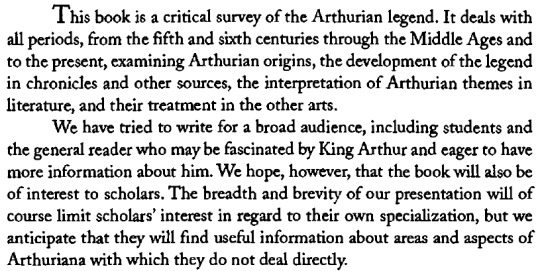
Encyclopedias & Handbooks
Warriors of Arthur by John Matthews, Bob Stewart, & Richard Hook
The Arthurian Companion by Phyllis Ann Karr
The New Arthurian Encyclopedia by Norris J. Lacy
The Arthurian Handbook by Norris J. Lacy & Geoffrey Ashe
The Arthurian Name Dictionary by Christopher W. Bruce
Essays & Guides
A Companion to Chrétien de Troyes edited by Joan Tasker & Norris J. Lacy
A Companion to Malory edited by Elizabeth Archibald
A Companion to The Lancelot-Grail Cycle edited by Carol Dover
Arthur in Welsh Medieval Literature by O. J. Padel
Diu Crône and The Medieval Arthurian Cycle by Neil Thomas
Wirnt von Gravenberg's Wigalois: Intertextuality & Interpretation by Neil Thomas
The Legend of Sir Lancelot du Lac by Jessie Weston
The Legend of Sir Gawain by Jessie Weston
#arthuriana#arthurian legend#arthurian mythology#arthurian literature#king arthur#queen guinevere#sir gawain#sir lancelot#sir perceval#sir percival#sir galahad#sir tristan#queen isolde#history#resource#my post
1K notes
·
View notes
Text

i think it's a shame that no one really talks about how in mort artu, the dying guinevere literally asks one of the nunnery maidens to cut out her heart and send it to lancelot 😭
#freak4freak of the generation... nay..... even the millenium.......#arthuriana#poppy speaks#vulgateposting#(i mean. post vulgate. but like that's my tag already unfortunately)
48 notes
·
View notes
Text
Queer Reading of the Vulgate Cycle pt 1: Preface
preface | intro pt 1 | intro pt 2
Some context on 1. this readthrough and 2. the Vulgate Cycle in general!
I've read large chunks of the Vulgate Cycle all out of order, sporadically, but I haven't read it from cover-to-cover yet. I want to remedy that, though I want to read it through a queer lens. (Also a trauma psychology lens, but I don't have a good shorthand term for that.)
The Vulgate Cycle (aka the Lancelot-Grail Cycle, the Prose Lancelot, or the Pseudo-Map Cycle) is an Arthurian romance composed between 1215 and 1235-ish, by Anonymous. Who may have been one person, but more likely was multiple authors. (I'm in the "multiple authors" camp, I can see no other explanation for the dramatic tone shift of The Quest for the Holy Grail. Or the History of the Holy Grail, for that matter.)
It's a massive text. It attempts to "elaborate the full story of the Arthurian era and to set that era in a framework of universal history" (so writes Norris J. Lacy in the preface to the translation).
The History of the Holy Grail (originally the "Estoire del saint Graal") - actually one of the last sections to be written, even if its contents come first chronologically. Traces the early history of the Grail and Grail-keepers. Lots of Bible fanfic bits in this one. My least favorite section (I find it tedious and dull).
The Story of Merlin - also one of the last sections to be written. Focuses on Merlin and his role in Arthur's conception, birth, and coronation. Also focuses on Arthur's early days as king, and some of his early knights (young Orkney brothers!), and Arthur's early relationship with Guinevere (back when things were really good between them).
Lancelot Proper (aka Le Roman de Lancelot, Lancelot propre, or just "Lancelot du Lac") - Lancelot's life and adventures (and everyone else's adventures that end up vaguely connected to him) from birth until… right before the Grail quest. Divided into 3-6 parts by modern scholars (Lacy divides it into 6, so that's what I'll be going with).
The Quest for the Holy Grail (La Queste del saint Graal) - My second-least-favorite section; it's less tedious and dull than the History, but it's such a departure from the tone of the rest of the Vulgate Cycle, and it feels like a text designed to convert people to Christianity (and that may indeed have been its intended purpose). It's possible that the tone shift might be because each sectio nhad a different translator, but I don't think that explains it sufficiently.
The Death of Arthur (La Mort Artu) - the most readable section, imho, and probably my favorite. It promptly unravels all the purity nonsense that Quest put into place (feels like when a show gets a new showrunner for a season, and then the old showrunner gets the reins back a season later and is doing damage control on all the weird turns that the interim showrunner took), Lancelot and Guinevere get back together, and the story leaps into intense drama and beautiful tragedy.
Then there's the Post-Vulgate, which is basically just a grimdark and more religious rewrite of the Vulgate, minus the Lancelot Proper. Lots more Grail focus. I don't know if I'll do a readthrough of it or not.
The specific translation notes in the Preface are fascinating, and I highly recommend them (I love translation notes), but the most relevant bit is this:
"…the translators have tried to steer a middle course. Our primary concern was to present a reliable and readable text to modern readers, but we have also made an effort to retain a certain number of the stylistic features of the Old French romances, provided those features were reasonably compatible with the characteristics of modern English usage.
Lacy warns the reader that the History of the Holy Grail has "a convoluted, dense style" far more than most texts of the period. (It's so tedious, do not recommend.) "The author appears to be far more concerned with substance and symbolism… than with concision and grace." They've cleaned up the text in some places but overall kept the characteristics of the style. If this is the more accessible version, I would not want to read a literal direct translation. D:
Next up: Introduction (more translation notes) to the History of the Holy Grail.
#arthurian literature#queer reading of the vulgate#qrv#arthuriana#vulgate cycle#arthurian newbie#though I should probably change that tag to something else#it doesn't apply so much anymore#but it's my read-through-Arthurian-lit tag at the moment soooo
29 notes
·
View notes
Text
Arthurian myth: King Arthur (1)
Loose translation of the article "Arthur (Artus)" from Catherine Rager's "Dictionnaire des fées et des peuples invisibles dans l'Occident païen" (Dictionary of fairies and invisible people in the Pagan Occident).
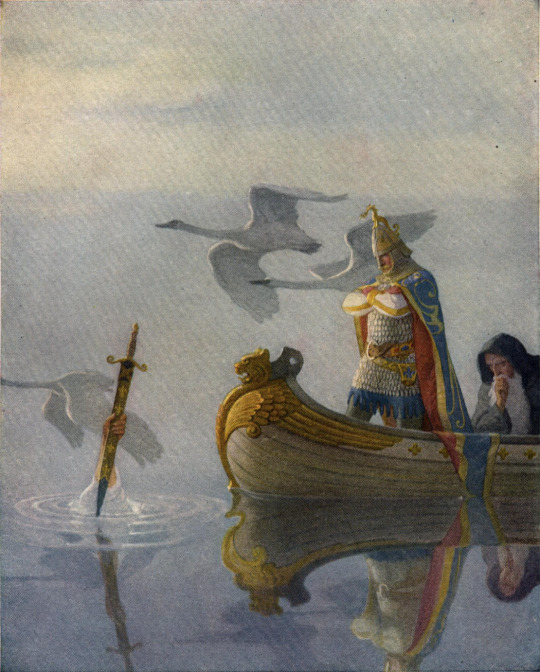
ARTHUR (Artus)
Mythical king of a cycle of romans, the tales of the Round Table, also known as the Matter of Britain, which blossomed throughout all of Europe from the 12th to the 15th centuries. Among those texts, we find numerous romans by Chrétien de Troyes, and The History of the Kings of Britain by Geoffroy of Monmouth, alongside its very loose translation Le Roman de Brut by Wace, itself rewrote by the priest Layamon in his poem Brut, and later, by Malory in his La Mort d'Arthur. Arthur was originally a historical warlord killed around 537 at the battle of Camlann, but he then became a super-human character identified to another Arthur, the great god of the pantheon of the Britons, and thus symbolizing the fight of the old kings of Great-Britain against the Saxon invaders.
The father of Arthur is the king Uter Pendragon who, despite his human appearance, seems to be a figuration of an Underworld king. He claims to be Constantine's descendant - the Celts, during this era, were Romanized. Arthur's half-sister is the fairy Morgane. As for his wife, the incomparable Guenievre ou Guinevere, her name means in its Welsh form (Gwenhwyfar, Gwenhwyvar) "white spirit", "white ghost". Some considered that Guenievre, who is recurringly kidnapped, is a resurgence of the Greek goddess Persephone. Their son, Llacheu, has the gift of second-sight/clearsight, as he knows the secret of material elements and of nature.
The relationships between Arthur and the Otherworld make him a magical character. In the roman of the Saxon Layamon, Brut, we see elves assist to his birth and gift him - he will be powerful, wealthy, generous and have a long life.
As many other heroes, Arthur receives his sword, Excalibur, from a supernatural creature. It is the Lady of the Lake that offers it to him. Indeed, the weapon he took away from its rock had been broken during a previous battle. Merlin, to replace it, brought the king to the shore of a lake, where an arm with white silk came out of the water, offering him the magical sword ornate with dragons - it is Excalibur, the Caladbolg of the Irish Fergus, a sword forged in Avallon. Before his death, the king will task sir Bedevere with bringing back Excalibur to the lake, where the mysterious arm appears again out of the water and takes it back. The Lady of the Lake always offers her protection to the king.
Arthur rides a black horse, a color associated to the realm of the dead: he can, as such, cross the waters that separate the afterlife from the realm of the living without his horse going wild with terror. The Book of Taliesin, a Welsh text of the 13th century, tells how the king went to the Underworld and brought back from it a magical cauldron (prefiguration of the Grail) which offers to knights an endless supply of food, but stays empty for the cowards.

Arthur is a purifying hero who gets rid of the monsters that plague the universe, just like Hercules, Theseus, Finn mac Cumhail or Cûchulainn. His first exploit was to kill the boar Twrch Trwyth which was ravaging Wales (Mabinogion of Kulwch and Olwen).
Once king, Arthur represents a solar-themed strength and wisdom. Advised by Merlin the enchanter, he establishes a rule of peace and justice (for twelve years according to some, for forty according to others), and presides at Carduel the Round Table, whose nature confirms that Arthus is both belonging to the supernatural, and an image of the Sun. His court can be found at Camelot - which might be Cadbury Castle, in the Somerset, but is before all the idealized town, the perfect city, the seat of knowledge, poetry and alchemy. The court keeps moving depending on the tales. The lord regularly sends his knights fight for just causes (and, after the Christianization of the legend, for the quest of the Grail containing the blood of the Christ), but himself rarely appears as a warrior. He sometimes even appears to figure a god of war who is above the mere battle, similarly to the goddess Badb.
For a marvelous life, a prodigious end: in his Vita Merlini, Geoffroy of Monmouth tells how the king, killed by the treacherous Mordred, his nephew and likely incestuous son, is carried on a magical boat by fairies that came from the Atlantic (where the realm of the dead is located). He is accompanied there by the Lady of the Lake and by three queens: the queen of Northern Wales, the queen of the Terre Gaste, and Morgane. Healed of his wounds by the latter, he stays with her, the Lady of the Lake, and their six sister-fairies, in the island of Avallon, "The Isle of Apples", which is sometimes a name for the Sidh/realm of the fairies, sometimes synonymous with the Blessed Islands or Fortune Isles. In Layamon's Brut, it is elves that take to Avallon the dead king, and it is the elf-queen Argante that brings him back to life. In truth, he returned to the place he belongs to, this Otherworld where there is no death, no suffering, no decadence, but only youth, feast and joy. His people hope for his messianic return, either in times of war, or simply so that he can offer them wise advice. In Cornwall, king Arthur supposedly appears in the shape of a black bird with red-colored beak and claws.
Old texts from which Rabelais took his inspiration mixed together the legend of king Arthur and the one of the giant Gargantua.
In Guillaume Apollinaire's burlesque "Arthur roi passé roi futur" (Arthur, king past, king future, 1914), king Arthur returns, wearing a shining armor, to Buckingham Palace where Georges IX is ruling. After having tested the authenticity of the ghost, Georges IX abdicates and lets the throne return to the old lord of England.
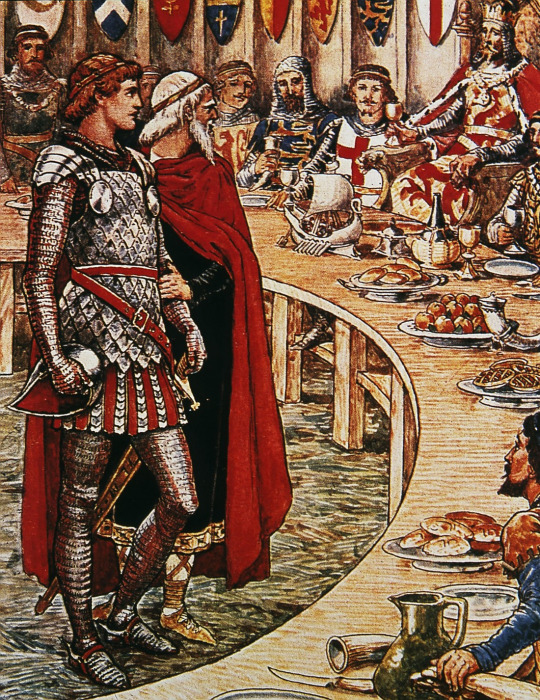
18 notes
·
View notes
Note
I figure you shouldn't really go into specifics in case of there being anything identifiable in it but I would gladly read about how your dissertation is going. Also, any particular favorite piece or subject from the body of myth?
i was planning on posting anyway about my dissertation because i literally cant shut up about it BUT i will definitely answer as much as i can for now (im writing this in my break from researching for it lmao)
[for context: my dissertation is about the view on scotland and scottish people in the lancelot-graal cycle, which is one specific rewriting of arthurian material of the middle of the 1200s]
so with that out of the way ill say favourite piece: definitely the last one of the cycle, mort le roi artu (death of king arthur) that is incredibly gritty and sad for a medieval romance. it is also increbily fucked up but that was fairly standard lol
than ill dooooo favourite character: if we're talking the whole body of arthurian literature i'd say perceval, because his quest is so fucking pointless and i love him. no its actually not pointless, but he sets out to search for the grail and ends up in an endless search of his identity and never gets to the grail because nobody tells him things so he doesnt know what hes supposed to do. poor him. but if we're talking just the lancelot-graal cycle i would say mordred, because hes much more explored here than in previous romances and hes such an interesting character. for those who dont know mordred is arthur's incestuous son, and also the one who kills him.
i could tell you guys s o m a n y m o r e t h i n g s !!! but i dont wanna be too much of a yapper ig. if anybody's interested i will be very happy to talk about this more and answers questions!!!!
#who knew writing a dissertation could be so fun#like its difficult to get through medieval texts but its worth it#for those asking: yes i have watched it#merlin#arthurian legends#arthuriana#arthurian mythology#asks#my dissertation
3 notes
·
View notes
Note
hello! i love your blog and your 'for the thesis' tag is especially intriguing to me (i'm very curious about medieval literature and history); would you be willing to talk a little about what your thesis is about, if you're comfortable with it? no problem if not! have a nice day :)
[wearing my neon pink "ask me about my thesis" t-shirt] haha yeah of course
SO the short answer is that I’m tackling various adaptations of Arthurian works through an ecocritical and racial lens.
The long answer is all of that, but with more detail, lol. I have a couple through-lines in my adaptations insofar as the histories they’re building upon— I’m tackling Le Morte d’Arthur by Malory, so I’m also tackling Tennyson’s Idylls of the King and TH White’s The Once and Future King. I’m looking at Sir Gawain and the Green Knight, so I’d also like to tackle The Green Knight (2021) (I might scrap that though, sadly) and, though this doesn’t as much fit into these two camps, I think Kazuo Ishiguro’s The Buried Giant slots in quite well with the concerns of SGGK. There are other works that I’m interested in too, though I don’t know to what extent or how much time I’ll be afforded: there’s a really interesting amount of adaptations of Chaucer’s the Wife of Bath’s Tale, with all that it holds, and I’d like to see if I can include Patience Agbabi’s Telling Tales and Zadie Smith’s The Wife of Willesden, which both adapt the story into a modern context, with a stronger focus on race— which is super interesting to me on the racial lens more than the environmental!
In an overarching sense, my thoughts are centered around the construction of capital-N Nature, nation and empire (you see this very heavily in Idylls of the King, unsurprisingly) through Arthurian legend as well as how those ideas are both corrupted (see The Buried Giant, The Green Knight) and boldened by adaptations, as well as the specific connections between empire and environment and how those lay the groundwork for thoughts around race.
The theoretical texts I’m working with are primarily Jeffrey Jerome Cohen’s Stone: An Ecology of the Inhuman, Iman Jackson’s Becoming Human: Matter and Meaning in an Antiblack World, Timothy Morton’s Hyperobjects: Philosophy and Ecology After the End of the World, Rob Nixon’s Slow Violence and the Environmentalism of the Poor, and Kathryn Yusoff’s A Billion Black Anthropocenes or None. I’m delighted to talk more about how these texts fit into my critical work, but this answer is already long enough lol!!!
I’m particularly curious about how/why adaptations of Arthurian legend are so concerned with nature and the environment (see The Once and Future King), and what about Arthurian legend makes it such a heady and rich place for analysis and environmentally concerned fiction. How does the constructed and real history of the UK/Britain/England as reflected through Arthuriana reveal anxieties and insights on environmental changes of the time? Can the fall of King Arthur’s court be used today as a metaphor for species extinction? Is the Anthropocene- and all the dicey territory that comes with such a term- in Camelot? Is the Holy Grail a Hyperobject? Where do Hyperobjects appear in Arthurian adaptations? How does environmentalism interact with race in these adaptations, and in their historical situations?
My thesis tag is a little misleading insofar as there are quite a couple posts in there that don’t really have anything to do with my thesis in particular, but rather just remind me of it and the stuff I’m working on!!!
Thank you for asking and loving my blog hehe :3 I hope this answered your question and if you have any more questions or anything like that feel free to ask or also dm me if you prefer :D
(edit: OH there's also another work I'm super interested in though I need to bring this one up to my thesis advisor called King Artus: A Hebrew Arthurian Romance of 1279 which is super fascinating on both a racial and 'adaptational' (to which that can be discussed as an appropriate term) level)
#asks#[sound of inbox pinging] [sound of large door being broken down] oh no you've released the monster. the thesis rambling monster#its only an undergrad thesis so it's not exactly going to be incredible scholarly work but i think im doing interesting stuff that hasn't#been quite tackled before or at least not in the ways im interested in tackling them#so im pretty excited :)#thank you for askingggg#i do think the holy grail counts as a hyperobject. btw.
7 notes
·
View notes
Note
(I am full aware you were joking don't take me seriously) Listen (listen!) Agravain may not be the worst and he may not be the best but! He Is.
And honestly I think it's pretty good to Be. Just... Be. (Even tho technically he's dead. So I guess he Isn't.)
Also both Gaheris and Gareth get mixed up pretty often so I will say he is the most likely to be remembered amongst Gawain's (official) siblings.
A random person who loved Agravain in La Mort Artu
god ur right thanks to lancelot he cant even be just some guy, he has to were just some guy . sad! oh well
8 notes
·
View notes
Text
King Lot in the Chronicle Traditions, pt. II: Didot Perceval - Mort Artu
(Here is the Mort Artu found attached to the Didot Perceval of The Robert de Boron Cycle. Now, the Didot and its cycle are technically Romances and thus part of the Romance Tradition. But the Mort Artu follows the Chronicle narratives so closely, that I consider it an honorary part of the Chronicles.)

King Lot and his son, Gawain, prepare to aid King Arthur's plans for World Domination.

Lot and Gawain act as messengers to the King of France. Sir Gawain being the Golden-Tongued Knight, just as the Welsh writers intended.

King Lot sitting next to Arthur, as a sign of his greater prominence and importance in this story. Which is why it's unfortunate to note that this story omits the invasion of Norway and the coronation of Lot as King of Norway.

King Lot tells the story of how the Romans rose to power and why they ought to crush the Roman Empire. Originally, in Geoffrey's narrative, it was Lot's brother, Augusel, and King Hoel who explain the story of Romans and urge Arthur to go to war with them.

Here is King Lot and Sir Gawain being the badass Father-Son duo the Romances have denied us.

Mordred's betrayal. In light of later stories, the sheer tragi-comedy of King Lot being present for the Fall of Camelot will never cease to amaze me.

King Lot and Sir Gawain's tragic demise.
Didot Percival's Mort Artu is my personal favorite of the Fall narratives. It's just an adaption of the original story by Geoffrey, with a few minor tweaks here and there - a different experience from the Romances' emphasis on making everything Lancelot-centric.
King Lot's enhanced role here is why I elected make this part of the posts - because it gives him a lot (lol) more to do than in Historia and ascribes him a larger story presence, despite losing the "King of Norway" story point.
And again, the cool premise of Gawain and his dad campaigning together.
Link to Part I: HERE
Link to Part III: HERE
Link to Part EX: HERE
#king lot in the chronicle traditions#king lot#sir gawain#didot perceval#sir mordred#king arthur#arthurian chronicle tradition#arthuriana#arthurian mythology#arthurian legend#mort artu#arthurian literature
16 notes
·
View notes
Text
Fate Grand Order Servant Comparisons
Gareth

Left - FGO
Right - Estoire del Saint Graal, La Queste del Saint Graal, Morte Artu
7 notes
·
View notes
Note
Your post was very informative, thank you very much! one last thing: I read somewhere that in Vulgate Morte Artu, peasants were begging Arthur not to burn Guinevere for the affair. Is this true?
you're welcome (hopefully I didnt make any egregious errors - I do my best to check my sources but im not infallible, and I don't work on Malory, but hopefully it was an ok overview of one (among many) ways of reading the final books)!!
The people certainly lament for her and cry in pity 'as if the queen were their mother'. If you're interested in the ways in which the common people might influence the political choices of the court, might I suggest the Stanzaic Morte? In the Stanzaic, the war with lancelot is criticised because it causes widespread famine amongst the people, as not only does an army need to be fed, a common (and extremely brutal) medieval warfare tactic was the 'chevauchée', during which fields would be systematically burned and destroyed.
4 notes
·
View notes